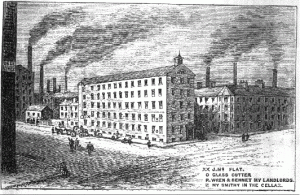The working conditions endured by these workers were absolutely not ideal to any human. These children and adults were subjected to strenuous working hours and horrible conditions in the factory. The factories were without any air conditioning so it was a very heated atmosphere.[i] This caused harsh conditions because each worker was subjected to one position for the duration of their work day. In children, this caused serious growth issues. A child sitting in one place for thirteen hours a day caused the spine to become deformed and bulge out laterally. It also caused children to develop bowed legs due to the stress the pelvis was under when the spine became deformed.[ii] These conditions were not ideal to children but it was necessary for some children to work to help provide for their families.
With working conditions not very appealing to adults or children, factories needed workers and workers needed money to provide for their families. Workers never had the option to demand any increase in pay or demand better working conditions. Factory owners were very strict in the sense that they saw every worker, no matter if it was a child or an adult, as expendable. This was a time period where everyone was looking for secure work so if a worker was going against the management of the factory that person was expendable so management just found another person willing to work with the provided conditions.
[i] The Physical Deterioration of the Textile Worker
[ii] The Physical Deterioration of the Textile Worker

